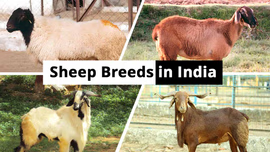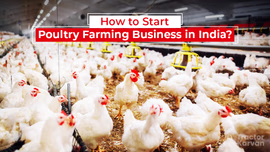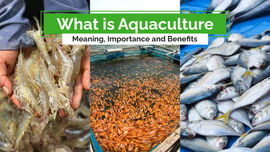What is Cage Culture in Aquaculture and Its Importance in India

Table Of Contents
- Overview of Aquaculture & Cage Culture
- What is Cage Culture?
- What is the Importance of Cage Culture in India?
- What are the Benefits of Cage Culture in India?
- What are the Contributing Factors behind Cage Culture in India?
- How to Start Cage Culture Fish Farming in India?
- Final Thoughts
Overview of Aquaculture & Cage Culture
Aquaculture is the farming of aquatic organisms. It has a substantial role in fulfilling the growing demand for fish globally. Fishing is a primary sector in the Indian economy, contributing 1.07 per cent of the total GDP. India is the third-largest producer of fish in the world, contributing to 7.96% of the total fish production globally. It is the second largest producer of fish through aquaculture. The total fish produced in the country in the financial year 2020-21 is around 14.73 million metric tonnes. India has adopted various aquaculture techniques.
Cage culture involves rearing fish in cages submerged in natural water bodies. This technique has been gaining momentum in India because it can boost seafood production.
What is Cage Culture?
Cage culture involves the use of cages or nets suspended at various depths in natural water bodies. These cages are typically made of floating materials, such as plastic or metal frames, so that they can float on the water's surface. The fish raised in the cage are fed a balanced diet. Their growth is monitored and facilitated under controlled conditions.
Cage culture fish farming is better than traditional open-water fish farming practices because of many reasons. Unlike traditional pond-based aquaculture, cage culture influences the natural environment's water flow and quality.
What is the Importance of Cage Culture in India?
Cage culture is gaining a foothold in India and is now being deployed to rear and breed fish on a larger scale. The Department of Animal Husbandry has recognised the importance of cage culture in increasing fish production in India. Hence, it launched the Mission Cage Culture 2022 to achieve the additional fish production of 75,000 metric tonnes. It is one of many government schemes to promote fish farming in India.
What are the Benefits of Cage Culture in India?
- Cage culture increases fish production from reservoirs and lakes responsibly without affecting the livelihood of local fishing communities.
- It also increases the availability of fish protein for the entire population.
- There is an improvement in the fisher's income and income security depending on inland fisheries resources.
- It facilitates sustainable and inclusive aquaculture growth in coordination with natural resource conservation.
- Cage culture enables aquaculture without harming the interests of other stakeholders of land and water resources.
What are the Contributing Factors behind Cage Culture in India?
The numerous factors causing cage culture in India are:
- Increasing fish consumption and declining wild fish stocks have increased interest in fish production through cage culture.
- Small farmers are searching for alternatives to traditional agricultural practices.
- Cage culture helps make high fish production possible, which makes its role significant in improving the country's overall fish production.
How to Start Cage Culture Fish Farming in India?
Site Selection
Site selection is the first step in cage culture fish farming. The physicochemical factors, such as pollution, oxygen, salinity, temperature, wave action, water exchange, and algae blooms, should make an ideal habitat for the species to flourish. The other factors which need to be considered are weather conditions, shelter availability, and substrate depth.
Some additional factors also need to be considered when deciding on a site for cage culture, such as access, social and economic safety, closeness to fishing harbours, market considerations, and many more. At least 5 metres of water column depth is recommended, and there must not be any industrial or local contamination in the water supply. It should be clear and flow freely.
The site should be covered by bays in medium and large-sized reservoirs to protect it against severe windy conditions. The irrigation channels and sluice gates may cause trouble for the cage if it is not anchored deep enough in the reservoir.
The marine and land transportation access is important. You need to ensure that no algae blooms are present to prevent fouling. Aquatic macrophytes and large concentrations of wild fish depleting the oxygen content in the water should be neglected. Cages should not be placed in ways to avoid obstruction of traffic, and ghats where people take a bath should not be considered.
Selection of Fish Species
The selection of fish species should be made by considering many biological factors, such as hardiness, disease resistance, high-quality seed availability, rapid growth, and effective food conversion. The highly suitable fish species for sea cage farming are Cobia (Rachycentron canadum), Spiny Lobster (Panulirus sp.), Groupers (Epinephelus sp.), Snappers (Lutjanus sp.), Seabass (Lates calcarifer), and Silver Pompano (Trachinotus blochii).
Types of Cages & Cage Size used in Cage Culture
There are three types of cages used in aquaculture: fixed cages, float cages, and submerged cages. A fixed cage is the most basic type of cage and is widely used in cage culture.
As per the guidelines of the Central Marine Fisheries Research Institute (CMFRI), a circular cage of 6 m in diameter and 4 m in depth or a rectangular cage of 6 X 4 X 4 m can be used. The cage should be encircled by a bigger outer net with a gap of one meter around it. Moreover, a bird net is also overlaid on the cage frame.
Stocking of the Yield
Stocking density impacts production and growth. The stocking and estimated harvest quantities of different fish species are listed below:
|
Species |
Stocking Size (Length/Weight) |
Stocking Density (Nos./cu. m) |
Production per Cage (in kg) |
|
Grouper |
15 cm/ 40 g |
15-20 |
2000 kg/ 7 months |
|
Seabass |
10 cm/ 30 g |
30-40 |
2000 kg/ 8 months |
|
Pompano |
10 cm/ 35 g |
30-40 |
1800 kg/ 8 months |
|
Cobia |
15 cm/ 35 g |
8-10 |
2400 kg/ 7 months |
Cage Management
Cage management practice involves optimising fish production at a minimum cost. Effective management depends on the farm operator's expertise and feeding rate, monitoring environmental conditions, limiting disease and predator loss, stocking density, and other technical issues.
The complete cage structure, including mooring and cage frame, should be inspected routinely and required repairs and maintenance work should be done. Bio-fouling jams the mesh of net cages, reducing the rate of water exchange. This results in stress due to low oxygen and accumulated waste, leading to fish mortality. Thus, regular brushing of the mesh of net cages is also important.
Harvesting in Cage Culture
Harvesting a cage culture should be done while considering market demands to ensure maximum profitability. Partial harvesting of the stock can also be done to avoid a glut on the market and a consequent drop in the selling price. In partial harvesting, the bigger fish must be harvested first. Maintaining the harvest record is also important at the harvesting site. Moreover, a post-harvest and marketing strategy is also required to achieve success in sea cage farming.
The cage culture centres must have facilities like fishing boats and gears, facilities for icing, holding and storage of the stock, live-fish transportation, connection to post-harvest processing centres, and market chains.
Final Thoughts
Cage culture in aquaculture is a risky job which requires a high level of caution. Thus, it is necessary to take proper safety precautions while practising cage culture fish farming. Some mandatory lifesaving equipment which must be installed at the cage site are communication devices, jackets, and first aid kits. People working in the sea cage must wear a lifejacket all the time. Cage aquaculture has the potential to contribute significantly to India's aquaculture sector because commercial quality fish production heavily depends on cage culture.
Frequently Asked Questions On What is Cage Culture in Aquaculture and Its Importance in India
1. What is cage culture?
Cage culture is the practice of rearing fish in cages submerged in natural water bodies, such as rivers, lakes, and reservoirs.
2. Is cage culture profitable?
The cage culture can be a profitable business in India because of the availability of live fish markets.


Related Blogs












